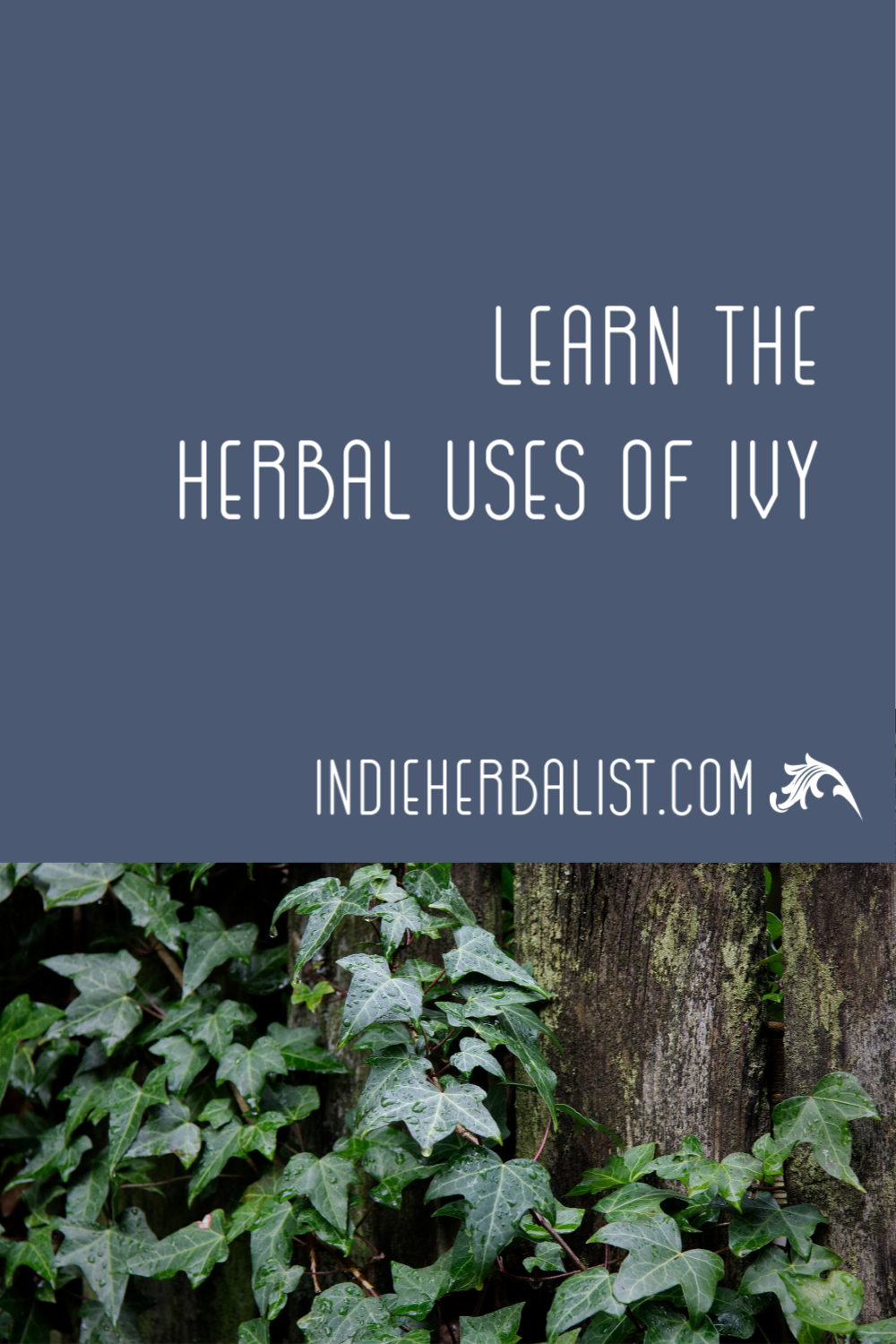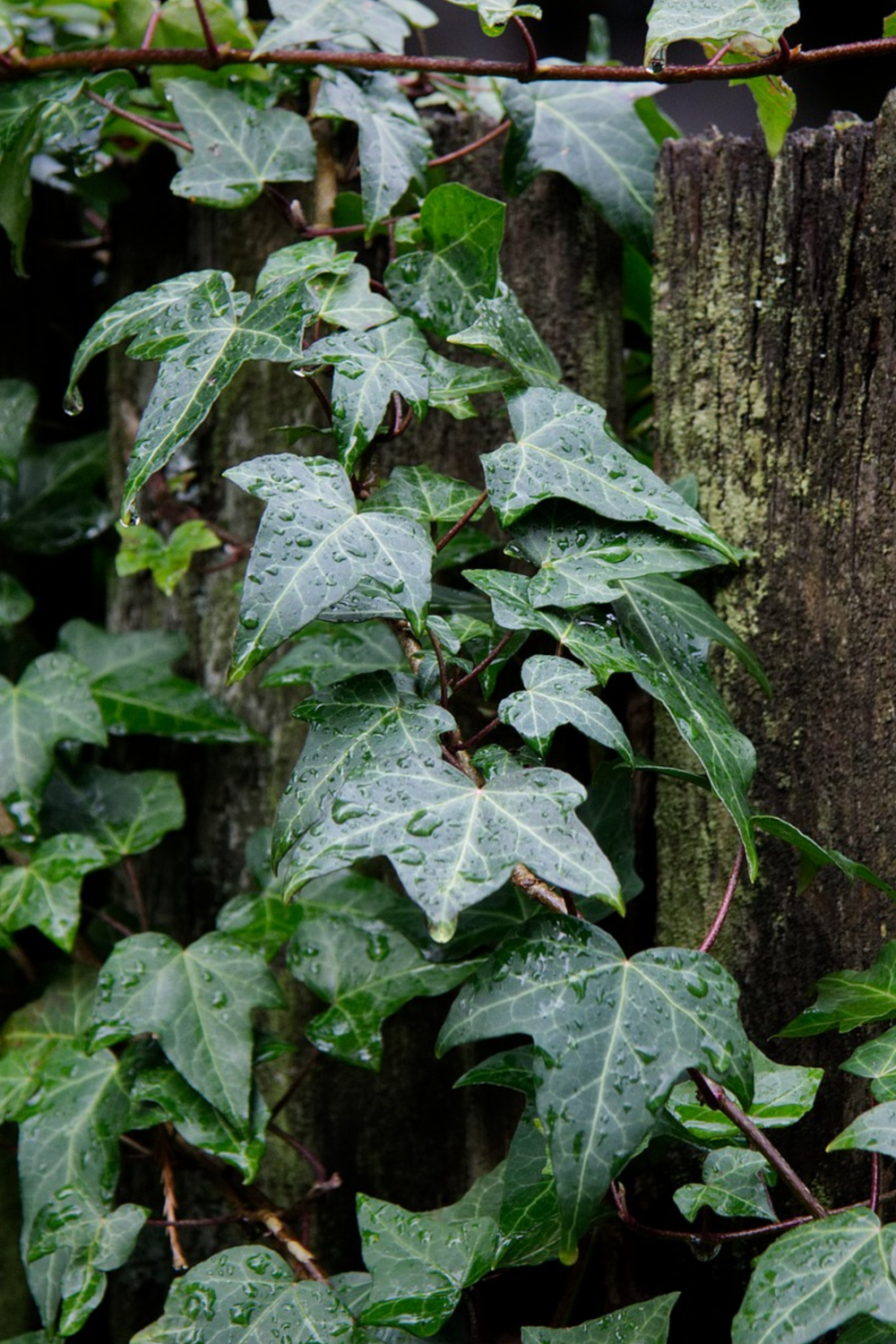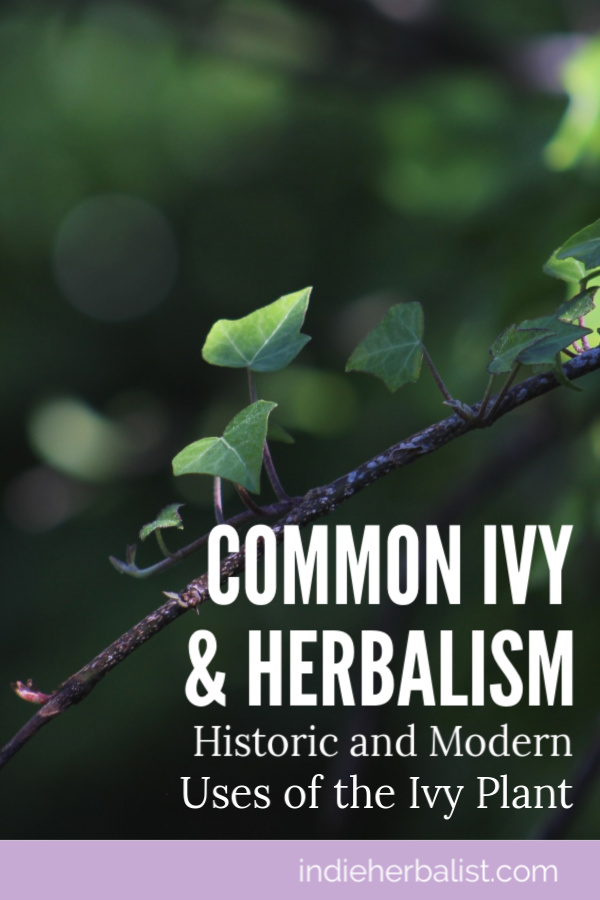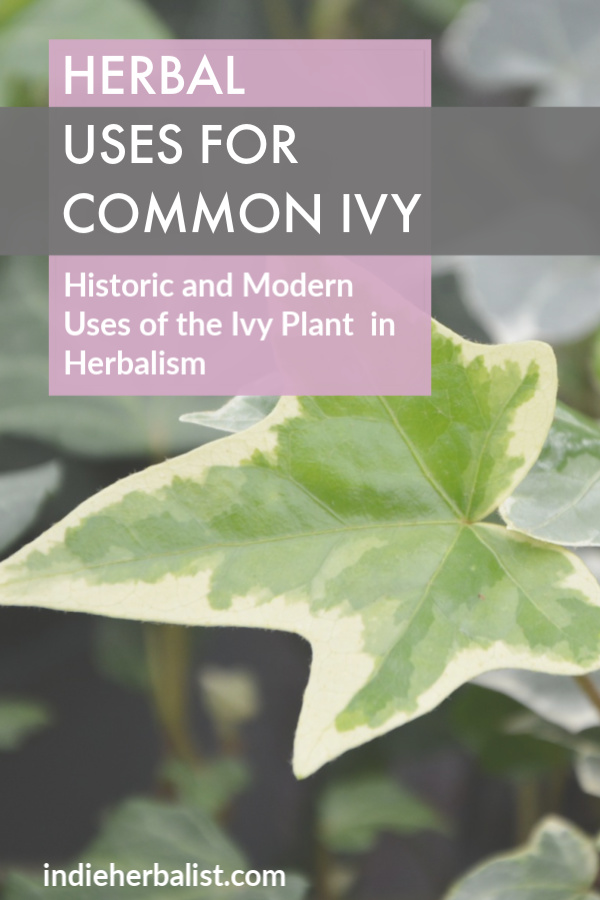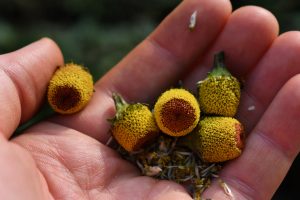Links contained in this post and elsewhere on my website may include affiliate links. When you make a purchase through these links, I earn a commission at no additional cost to you. I only link to products and services that I love - and that I think you will love, too!
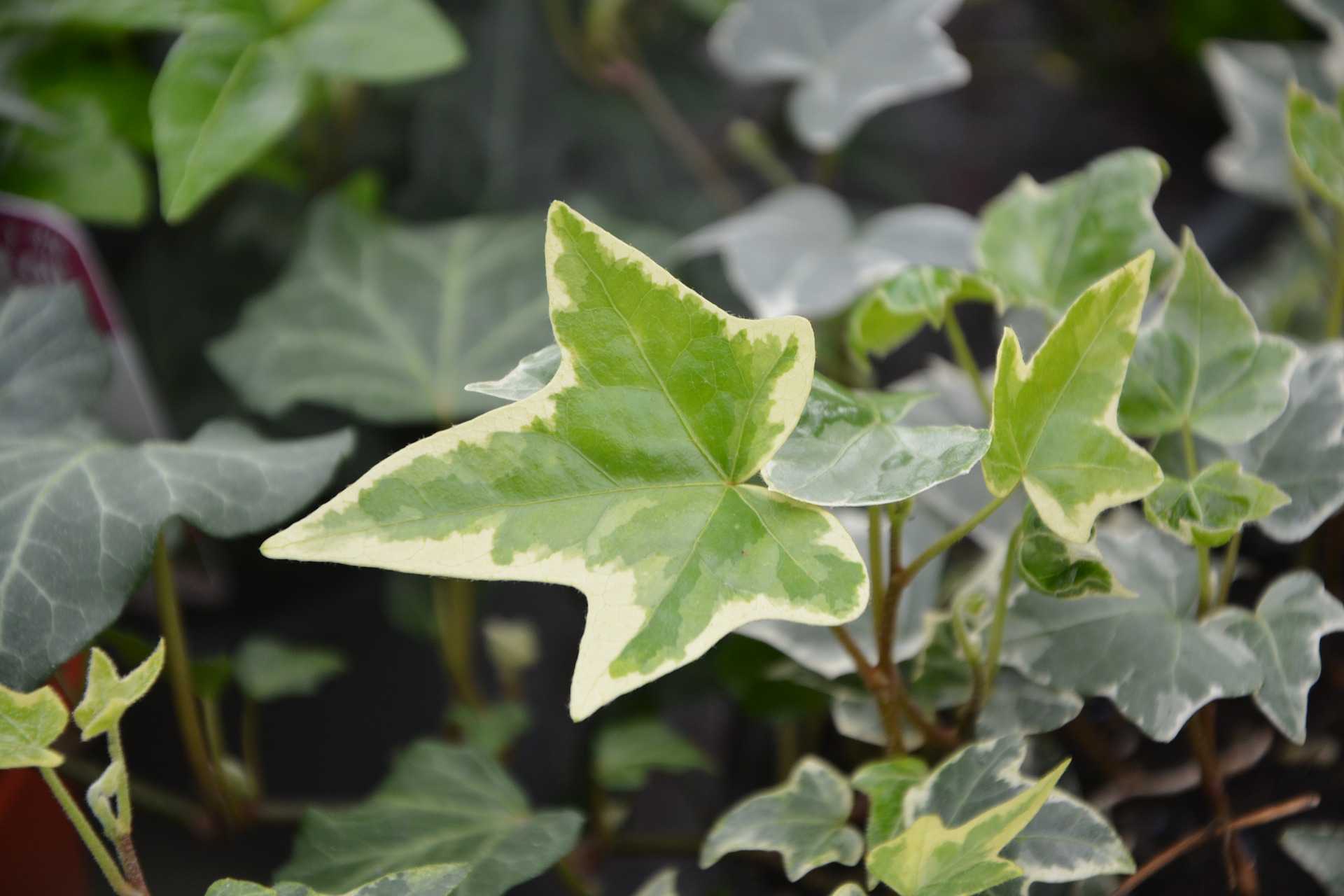
Hedera helix, or common ivy, is a familiar ornamental plant in modern households and gardens. It’s herbal history, on the other hand, has been all but forgotten! Let’s take a peek at some historical references and see what they have to say about the herbal uses for ivy!
A version of this article originally appeared on the Herbal Academy blog (#affiliate).
Ivy in the Garden
Ivy is a climbing evergreen vine. It happily climbs to a height of 80-90 feet, and spreads up to 50 feet wide. Ivy came to North American gardens as an ornamental in Colonial times. However, it is native to Europe.
Because it likes to climb, ivy is a decorative cover for walls and buildings. Unfortunately, it has a reputation as an invasive species in some areas outside of its native range.
According to the Missouri Botanical Garden, ivy actually has two stages of growth. The immature form of ivy is most common. In this stage, it grows as a ground cover or a vine, but usually prefers to climb. Once it matures, it develops bush-like qualities and grows shrubby stems. These stems flower in the fall and then produce blue-black berries.
Ivy in The Family Herbal
Once upon a time, however, ivy was more than just a landscape plant. In 1812, John Hill wrote an entry about English ivy in his book, The Family Herbal, that describes the many forms the leaves of the herb can take, and hints at some of ivy’s herbal past:
“A very common shrub, crawling about old trees, or upon old walls; it sometimes runs upon the ground for want of such support, but then it rarely bears any fruit. The trunk is thick, brown, and covered with a peculiar roughness. The branches are numerous and brittle. The leaves have a strange variety of shapes, oblong, angular, cornered, or divided. The flowers stand in little round clusters, and they are small and inconsiderable: they are succeeded by large berries. The leaves upon the young shoots that bear the flowers are always oblong; those on the trunk are angulated. They are all of a deep glossy green.
The leaves and berries are both used, but neither much. A decoction of the leaves destroys vermin in children’s heads, and heals the soreness that attends them. The berries are purging; an infusion of them will often work also by vomit, but there is no harm in this: they are an excellent remedy in rheumatisms, and pains of all kinds, and, it is said, have cured dropsies; but this is perhaps going too far.
The ivy in the warm countries sweats out a kind of resin, which has been used externally at some times, on various occasions; but at this time, it is quite unknown in practice.” (Hill, 1812)
Ivy in Culpeper’s Complete Herbal
In Culpeper’s Complete Herbal, first published in 1652, there is a very interesting entry on English ivy. It details a variety of herbal uses for both the leaves and berries. According to Culpeper, ivy was commonly prepared in a wine or as an infusion in water, and he recommends it to help dysentery, jaundice, and intestinal parasites. Topically, leaves and berries were applied to heal infected wounds, burns, and even for ear infections. Ivy was also used in that time period against the plague, and was considered to have diuretic properties (Culpeper, 1652).
Culpeper also informs us:
“The berries are a singular remedy to prevent the plague, as also to free them from it that have got it, by drinking the berries thereof made into a powder, for two or three days together. They being taken in wine, do certainly help to break the stone, provoke urine, and women’s courses. The fresh leaves of Ivy, boiled in vinegar, and applied warm to the sides of those that are troubled with the spleen, ache, or stitch in the sides, do give much ease. The same applied with some Rosewater, and oil of Roses, to the temples and forehead, eases the head-ache, though it be of long continuance. The fresh leaves boiled in wine, and old filthy ulcers hard to be cured washed therewith, do wonderfully help to cleanse them. It also quickly heals green wounds, and is effectual to heal all burnings and scaldings.”
Fast forward to 1898 in America, and King’s American Dispensatory notes many other uses of ivy. The Dispensatory includes skin infections, eczema, lice, glandular enlargements, lung problems, rickets, and toothache as potentially helped by ivy. It also notes that ivy is an emetic and cathartic, and a diaphoretic to cause sweating during fevers (“sweating out” a fever was common practice of the time). According to the Dispensatory, ivy can be applied topically for localized pain. (Felter, 1898).
Modern Herbal Uses for Ivy
Many modern gardening and veterinarian websites warn that ivy can be toxic to humans, pets, and livestock. However, this isn’t the full story. Ivy is an ingredient in herbal syrups available on the market today. The German Commission E, which publishes some of the most complete information available on herbal safety, has approved ivy leaf for several uses, including respiratory congestion and inflammatory conditions of the lungs. There’s even a recent study examining ivy’s safety as a children’s herb (Schmidt et al, 2012).
So why the dire warnings on toxicity? It’s true that the leaves and berries contain a substance called hederin that can be toxic in large amounts (U.S. Fish and Wildlife Service, 2010). Nausea and vomiting can occur with large doses of ivy, and yet the same can occur from other well-known herbs, such as lobelia (Cook, 1869).
It’s also good to know that fresh ivy leaves may cause contact dermatitis in some individuals. So can other common garden plants such as yarrow (Rucker, et al, 1991).
Ivy for the Home Herbalist
Despite a rich herbal history and modern uses in dietary supplements, most of ivy’s uses have been gradually forgotten. Knowing a little about the herbal uses for ivy gives us a new appreciation for this surprising herb. It’s perfect to study and include in your materia medica.
Do you want to become an herbalist? I recommend the online courses by The Herbal Academy! They have affordable courses for every level from beginner to advanced. Each course is thorough, well-researched, and beautifully presented. Learn more about their programs here (#affiliate).
References
Cook, William. (1869) The Physiomedical Dispensatory. Retrieved from: http://www.henriettes-herb.com/eclectic/cook/LOBELIA_INFLATA.htm
Culpeper, Nicholas. (1642). Culpeper’s Complete Herbal and English Physician. Retrieved from: http://www.complete-herbal.com/culpepper/ivy.htm
Grieve, Maude. (1931, 1971) A Modern Herbal. Retrieved from https://www.botanical.com/botanical/mgmh/i/ivycom15.html
Hill, John. (1812) The Family Herbal. Retrieved from: https://archive.org/details/mobot31753000976271
Felter, H., Lloyd, J. (1898) King’s American Dispensatory. Retrieved from http://www.henriettes-herb.com/eclectic/kings/hedera.html
Missouri Botanical Garden http://www.missouribotanicalgarden.org/PlantFinder/PlantFinderDetails.aspx?kempercode=r450
Rucker, G., Manns, D., Breuer, J. (1991) Peroxides as plant consituents. 8. Guainanolide-peroxides from yarrow, Achillea millefolium L., a soluble component causing yarrow dermatitis. Arch Pharm (Weinheim). 1991 Dec;324(12):979-81.
United States Fish and Wildlife Service (2010). Plant Invaders of Mid Atlantic Areas. Retrieved from: http://www.nps.gov/plants/alien/pubs/midatlantic/hehe.htm
Schmidt, M., Thomsen, M., Schmidt, U. (2012). Suitability of ivy extract for the treatment of paediatric cough. Phytother Res. 2012 Dec;26(12):1942-7. doi: 10.1002/ptr.4671. Epub 2012 Apr 25. Retrieved from: https://www.ncbi.nlm.nih.gov/pubmed/22532491

